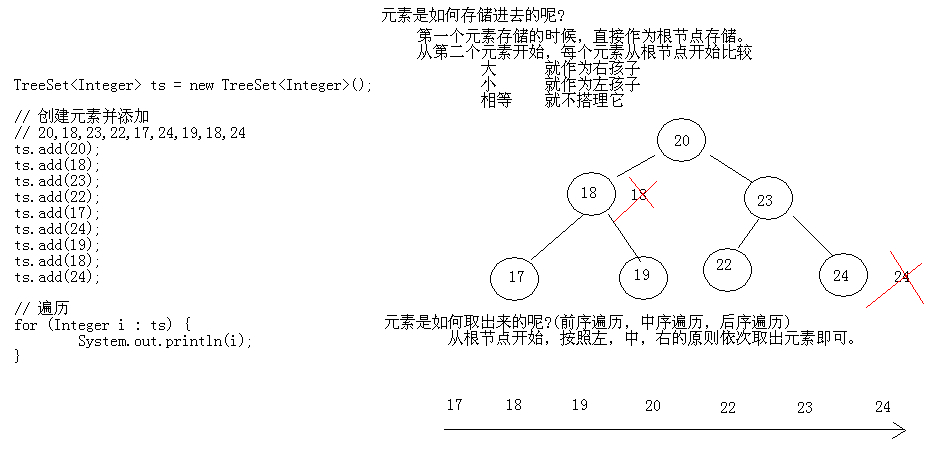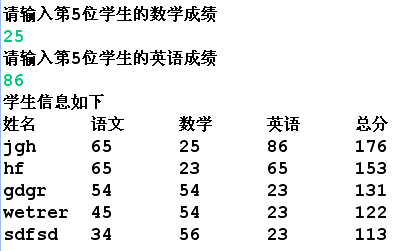17.01 ArrayList集合的toString()方法源码解析
代码:
Collection c = new ArrayList();
c.add("hello");
c.add("world");
c.add("java");
System.out.println(c);
输出c时默认调用的是c的toString()方法
A:Collection c = new ArrayList();
这是多态,所以输出c的 toString()方法,其实是输出ArrayList的toString()方法
B:看 ArrayList 的 toString()方法
在ArrayList里面却没有发现toString()。应该去父类查找→ AbstractList → AbstractCollection
C:toString()的方法源码
1 public String toString() 2 { 3 Iterator<E> it = iterator(); //集合本身调用迭代器方法,得到集合迭代器 4 if (! it.hasNext()) 5 return "[]"; 6 7 StringBuilder sb = new StringBuilder(); 8 sb.append('['); 9 for (;;) 10 { 11 E e = it.next(); //e=hello,world,java 12 sb.append(e == this ? "(this Collection)" : e); 13 if (! it.hasNext()) 14 //[hello, world, java] 15 return sb.append(']').toString(); 16 sb.append(',').append(' '); 17 } 18 }
17.02 Set集合概述及特点
Set接口概述:一个不包含重复元素的 collection
特点:
无序(存入与取出的顺序不一致)
唯一(存入集合的元素唯一)
17.03 HashSet存储字符串并遍历
HashSet类概述:不保证 set 的迭代顺序,特别是它不保证该顺序恒久不变。此类允许使用 null 元素。
例:
1 public class Practice 2 { 3 public static void main(String[] args) 4 { 5 HashSet<String> hs = new HashSet<String>(); 6 hs.add("hello"); 7 hs.add("world"); 8 hs.add("world"); 9 hs.add("java"); 10 11 for (String s : hs) 12 { 13 System.out.println(s); 14 } 15 } 16 }
运行结果:
hello
java
world
17.04 HashSet保证元素唯一性的源码解析
1 interface Collection 2 {...} 3 4 interface Set extends Collection 5 {...} 6 7 class HashSet implements Set 8 { 9 private static final Object PRESENT = new Object(); 10 private transient HashMap<E,Object> map; 11 12 public HashSet() 13 { 14 map = new HashMap<>(); 15 } 16 17 public boolean add(E e) 18 { //e=hello,world 19 return map.put(e, PRESENT)==null; 20 } 21 } 22 23 class HashMap implements Map 24 { 25 public V put(K key, V value) 26 { //key=e=hello,world 27 28 //看哈希表是否为空,如果空,就开辟空间 29 if (table == EMPTY_TABLE) 30 { 31 inflateTable(threshold); 32 } 33 34 //判断对象是否为null 35 if (key == null) 36 return putForNullKey(value); 37 38 int hash = hash(key); //和对象的hashCode()方法相关 39 40 //在哈希表中查找hash值 41 int i = indexFor(hash, table.length); 42 for (Entry<K,V> e = table[i]; e != null; e = e.next) 43 { 44 //这次的e其实是第一次的world 45 Object k; 46 if (e.hash == hash && ((k = e.key) == key || key.equals(k))) 47 { 48 V oldValue = e.value; 49 e.value = value; 50 e.recordAccess(this); 51 return oldValue; 52 //走这里其实是没有添加元素 53 } 54 } 55 56 modCount++; 57 addEntry(hash, key, value, i); //把元素添加 58 return null; 59 } 60 61 transient int hashSeed = 0; 62 63 final int hash(Object k) 64 { //k=key=e=hello, 65 int h = hashSeed; 66 if (0 != h && k instanceof String) 67 { 68 return sun.misc.Hashing.stringHash32((String) k); 69 } 70 71 h ^= k.hashCode(); //这里调用的是对象的hashCode()方法 72 73 // This function ensures that hashCodes that differ only by 74 // constant multiples at each bit position have a bounded 75 // number of collisions (approximately 8 at default load factor). 76 h ^= (h >>> 20) ^ (h >>> 12); 77 return h ^ (h >>> 7) ^ (h >>> 4); 78 } 79 }
通过查看add方法的源码,知道这个方法底层依赖两个方法:hashCode()和equals()。
判断元素唯一性的方式:通过对象的hashCode和equals方法来完成元素唯一性
如果对象的hashCode值不同,那么不用判断equals方法,就直接存储到哈希表中。
如果对象的hashCode值相同,那么要再次判断对象的equals方法是否为true。
如果为true,视为相同元素,不存。如果为false,那么视为不同元素,就进行存储。
如果类没有重写这两个方法,默认使用的Object()。一般来说不会相同。
17.05 HashSet存储自定义对象并遍历
1 public class Practice 2 { 3 public static void main(String[] args) 4 { 5 HashSet<Student> hs = new HashSet<Student>(); 6 7 hs.add(new Student("小明",23)); 8 hs.add(new Student("旺财",12)); 9 hs.add(new Student("旺财",12)); 10 hs.add(new Student("小强",24)); 11 hs.add(new Student("小明",22)); 12 hs.add(new Student("小红",22)); 13 14 for(Student s : hs) 15 { 16 System.out.println(s.getName()+":"+s.getAge()); 17 } 18 } 19 }
17.06 HashSet保证元素唯一性的代码体现
上例中重复元素被存入到了集合中,因为Student没有重写hashCode和equals方法,默认使用的Object()的hashCode和equals方法,一般来说结果不会相同,所以存入到了集合中,Student类应重写hashCode和equals方法(自动生成)。
1 @Override 2 public int hashCode() 3 { 4 final int prime = 31; 5 int result = 1; 6 result = prime * result + age; 7 result = prime * result + ((name == null) ? 0 : name.hashCode()); 8 return result; 9 } 10 11 @Override 12 public boolean equals(Object obj) 13 { 14 if (this == obj) 15 return true; 16 if (obj == null) 17 return false; 18 if (getClass() != obj.getClass()) 19 return false; 20 Student other = (Student) obj; 21 if (age != other.age) 22 return false; 23 if (name == null) 24 { 25 if (other.name != null) 26 return false; 27 } else if (!name.equals(other.name)) 28 return false; 29 return true; 30 }
17.07 LinkedHashSet的概述和使用
LinkedHashSet类概述:
元素有序唯一:由链表保证元素有序、由哈希表保证元素唯一
例:
1 public class Practice 2 { 3 public static void main(String[] args) 4 { 5 LinkedHashSet<String> hs = new LinkedHashSet<String>(); 6 hs.add("hello"); 7 hs.add("world"); 8 hs.add("world"); 9 hs.add("java"); 10 11 for(String s : hs) 12 { 13 System.out.println(s); 14 } 15 } 16 }
运行结果:
hello
world
java
17.08 TreeSet存储Integer类型的元素并遍历
TreeSet类概述:使用元素的自然顺序对元素进行排序,或者根据创建 set 时提供的 Comparator 进行排序,具体取决于使用的构造方法。
例:
1 public class Practice 2 { 3 public static void main(String[] args) 4 { 5 TreeSet<Integer> ts = new TreeSet<Integer>(); 6 ts.add(20); 7 ts.add(18); 8 ts.add(23); 9 ts.add(22); 10 ts.add(17); 11 ts.add(24); 12 ts.add(19); 13 ts.add(18); 14 15 for(Integer i : ts) 16 { 17 System.out.print(i+" "); 18 } 19 } 20 }
运行结果:
17 18 19 20 22 23 24
17.09 TreeSet保证元素排序的源码解析
1 interface Collection {...} 2 3 interface Set extends Collection {...} 4 5 interface NavigableMap {} 6 7 class TreeMap implements NavigableMap 8 { 9 public V put(K key, V value) 10 { 11 Entry<K,V> t = root; 12 if (t == null) 13 { 14 compare(key, key); // type (and possibly null) check 15 16 root = new Entry<>(key, value, null); 17 size = 1; 18 modCount++; 19 return null; 20 } 21 int cmp; 22 Entry<K,V> parent; 23 // split comparator and comparable paths 24 Comparator<? super K> cpr = comparator; 25 if (cpr != null) 26 { 27 do 28 { 29 parent = t; 30 cmp = cpr.compare(key, t.key); 31 if (cmp < 0) 32 t = t.left; 33 else if (cmp > 0) 34 t = t.right; 35 else 36 return t.setValue(value); 37 } while (t != null); 38 } 39 else 40 { 41 if (key == null) 42 throw new NullPointerException(); 43 Comparable<? super K> k = (Comparable<? super K>) key; 44 do 45 { 46 parent = t; 47 cmp = k.compareTo(t.key); 48 if (cmp < 0) 49 t = t.left; 50 else if (cmp > 0) 51 t = t.right; 52 else 53 return t.setValue(value); 54 } while (t != null); 55 } 56 Entry<K,V> e = new Entry<>(key, value, parent); 57 if (cmp < 0) 58 parent.left = e; 59 else 60 parent.right = e; 61 fixAfterInsertion(e); 62 size++; 63 modCount++; 64 return null; 65 } 66 } 67 68 class TreeSet implements Set 69 { 70 private transient NavigableMap<E,Object> m; 71 72 public TreeSet() 73 { 74 this(new TreeMap<E,Object>()); 75 } 76 77 public boolean add(E e) 78 { 79 return m.put(e, PRESENT)==null; 80 } 81 }
真正的比较是依赖于元素的compareTo()方法,而这个方法是定义在 Comparable里面的。
所以,要想重写该方法,就必须是先实现 Comparable接口。这个接口表示的就是自然排序。
17.10 TreeSet保证元素唯一性和自然排序的原理和图解

17.11 TreeSet存储自定义对象并遍历练习1
Student类实现自然排序接口Comparable,重写compareTo()方法
1 @Override 2 public int compareTo(Student s) 3 { 4 //主要条件,按年龄排 5 int num = this.age - s.age; 6 //次要条件,年龄相同按姓名排 7 int num2 = (num == 0)?this.name.compareTo(s.name):num; 8 return num2; 9 }
17.12 TreeSet存储自定义对象并遍历练习2
Student类实现自然排序接口Comparable,重写compareTo()方法
1 @Override 2 public int compareTo(Student s) 3 { 4 // 主要条件 姓名的长度 5 int num = this.name.length() - s.name.length(); 6 // 姓名的长度相同,比较姓名的内容是否相同 7 int num2 = num == 0 ? this.name.compareTo(s.name) : num; 8 // 姓名的长度和内容相同,比较年龄是否相同,继续判断年龄 9 int num3 = num2 == 0 ? this.age - s.age : num2; 10 return num3; 11 }
17.13 TreeSet保证元素唯一性和比较器排序的原理及代码实现
1 // 比较器排序,让集合具备比较性,匿名内部类实现 2 TreeSet<Student> ts = new TreeSet<Student>(new Comparator<Student>() 3 { 4 @Override 5 public int compare(Student s1, Student s2) 6 { 7 // 姓名长度 8 int num = s1.getName().length() - s2.getName().length(); 9 // 姓名内容 10 int num2 = num == 0 ? s1.getName().compareTo(s2.getName()) : num; 11 // 年龄 12 int num3 = num2 == 0 ? s1.getAge() - s2.getAge() : num2; 13 return num3; 14 } 15 16 });
17.14 TreeSet对元素排序的总结
唯一性:根据比较的返回的是否是0来决定
排序: 1.自然排序,一个类的元素想要进行自然排序就必须实现自然排序接口Comparable(元素具备比较性)
2.比较器排序,让集合的构造方法接收一个比较器接口的子类对象Comparator(集合具备比较性)
17.15 产生10个1-20之间的随机数要求随机数不能重复案例简洁版
编写一个程序,获取10个1至20的随机数,要求随机数不能重复。
1 public class Practice 2 { 3 public static void main(String[] args) 4 { 5 // 创建随机数对象 6 Random r = new Random(); 7 8 // 创建一个Set集合 9 HashSet<Integer> ts = new HashSet<Integer>(); 10 11 // 判断集合的长度是不是小于10 12 while (ts.size() < 10) 13 { 14 int num = r.nextInt(20) + 1; 15 ts.add(num); 16 } 17 18 // 遍历Set集合 19 for (Integer i : ts) 20 { 21 System.out.println(i); 22 } 23 } 24 }
17.16 键盘录入学生信息按照总分排序后输出在控制台案例
Student类
1 public class Student 2 { 3 private String name; 4 private int chinese; 5 private int math; 6 private int english; 7 public Student(String name, int chinese, int math, int english) 8 { 9 super(); 10 this.name = name; 11 this.chinese = chinese; 12 this.math = math; 13 this.english = english; 14 } 15 public String getName() 16 { 17 return name; 18 } 19 public void setName(String name) 20 { 21 this.name = name; 22 } 23 public int getChinese() 24 { 25 return chinese; 26 } 27 public void setChinese(int chinese) 28 { 29 this.chinese = chinese; 30 } 31 public int getMath() 32 { 33 return math; 34 } 35 public void setMath(int math) 36 { 37 this.math = math; 38 } 39 public int getEnglish() 40 { 41 return english; 42 } 43 public void setEnglish(int english) 44 { 45 this.english = english; 46 } 47 48 public int getSum() 49 { 50 return this.chinese+this.english+this.math; 51 } 52 }
测试类
1 public class Practice 2 { 3 public static void main(String[] args) 4 { 5 TreeSet<Student> ts = new TreeSet<Student>(new Comparator<Student>() 6 { 7 @Override 8 public int compare(Student s1, Student s2) 9 { 10 //按总分比较 11 int num1 = s2.getSum() - s1.getSum(); 12 //总分相同按语文成绩比较 13 int num2 = num1==0?s1.getChinese() - s2.getChinese():num1; 14 //语文成绩相同按数学成绩比较 15 int num3 = num2==0?s1.getMath() - s2.getMath():num2; 16 //数学成绩相同按英语成绩比较 17 int num4 = num3==0?s1.getChinese() - s2.getChinese():num3; 18 //英语成绩相同按姓名比较 19 int num5 = num4==0?s1.getName().compareTo(s2.getName()):num4; 20 return num5; 21 } 22 }); 23 for (int i = 1; i <= 5; i++) 24 { 25 Scanner sc = new Scanner(System.in); 26 System.out.println("请输入第"+i+"位学生的姓名"); 27 String name = sc.nextLine(); 28 System.out.println("请输入第"+i+"位学生的语文成绩"); 29 String chinese = sc.nextLine(); 30 System.out.println("请输入第"+i+"位学生的数学成绩"); 31 String math = sc.nextLine(); 32 System.out.println("请输入第"+i+"位学生的英语成绩"); 33 String english = sc.nextLine(); 34 35 Student s = new Student(name, Integer.parseInt(chinese), Integer.parseInt(math), Integer.parseInt(english)); 36 ts.add(s); 37 } 38 System.out.println("学生信息如下"); 39 System.out.println("姓名 语文 数学 英语 总分"); 40 for(Student s:ts) 41 { 42 System.out.println(s.getName()+" "+s.getChinese()+" "+s.getMath()+" "+s.getEnglish()+" "+s.getSum()); 43 } 44 } 45 }
运行结果:
